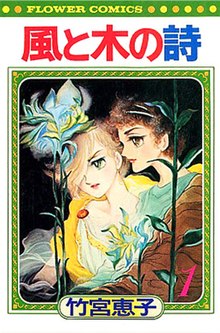
Back قصيدة الريح والأشجار Arabic Kaze to Ki no Uta Catalan Kaze to Ki no Uta German Kaze to Ki no Uta Spanish Kaze to ki no uta French Il poema del vento e degli alberi Italian 風と木の詩 Japanese 바람과 나무의 시 Korean Kaze to Ki no Uta Malay Kaze to ki no uta Polish
| Kaze to Ki no Uta | |
 The cover of the first tankōbon volume, featuring Gilbert (left) and Serge (right) | |
| 風と木の詩 | |
|---|---|
| Genre | Shōnen-ai[1] |
| Created by | Keiko Takemiya |
| Manga | |
| Written by | Keiko Takemiya |
| Published by | Shogakukan |
| Magazine |
|
| Demographic | Shōjo |
| Original run | February 29, 1976 – June 1984 |
| Volumes | 17 |
| Original video animation | |
| Kaze to Ki no Uta Sanctus: Sei Naru Kana | |
| Directed by | Yoshikazu Yasuhiko |
| Music by | Nobuyuki Nakamura |
| Released | November 6, 1987 |
| Runtime | 60 minutes |
| Sequels and related works | |
| |
Kaze to Ki no Uta (Japanese: 風と木の詩, lit. "The Poem of Wind and Trees" or "The Song of Wind and Trees") is a Japanese manga series written and illustrated by Keiko Takemiya. It was serialized in the manga magazine Shūkan Shōjo Comic from 1976 to 1980, and in the manga magazine Petit Flower from 1981 to 1984. One of the earliest works of shōnen-ai (a genre of male-male romance fiction aimed at a female audience), Kaze to Ki no Uta follows the tragic romance between Gilbert Cocteau and Serge Battour, two students at an all-boys boarding school in late 19th-century France.
The series was developed and published amid a significant transitional period for shōjo manga (manga for girls), as the medium shifted from an audience composed primarily of children to an audience of adolescents and young adults. This shift was characterized by the emergence of narratively more complex stories focused on politics, psychology, and sexuality, and came to be embodied by a new generation of shōjo manga artists collectively referred to as the Year 24 Group, of which Takemiya was a member. The mature subject material of Kaze to Ki no Uta and its focus on themes of sadomasochism, incest, and rape were controversial for shōjo manga of the 1970s; it took nearly seven years from Takemiya's initial conceptualization of the story for her editors at the publishing company Shogakukan to agree to publish it.
Upon its eventual release, Kaze to Ki no Uta achieved significant critical and commercial success, with Takemiya winning the 1979 Shogakukan Manga Award in both the shōjo and shōnen (manga for boys) categories for Kaze to Ki no Uta and Toward the Terra, respectively. It is regarded as a pioneering work of shōnen-ai, and is credited by critics with widely popularizing the genre. An anime film adaptation of the series, Kaze to Ki no Uta Sanctus: Sei Naru Kana (風と木の詩 SANCTUS-聖なるかな-, lit. "The Poem of Wind and Trees Sanctus: Is It Holy?"), was released as an original video animation (home video) in 1987.
© MMXXIII Rich X Search. We shall prevail. All rights reserved. Rich X Search